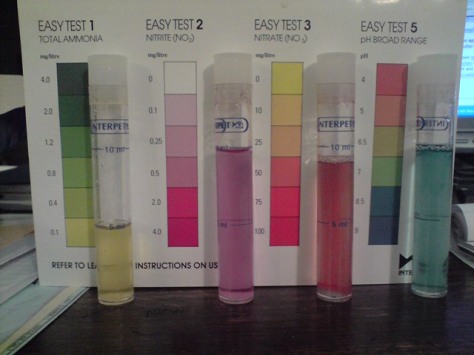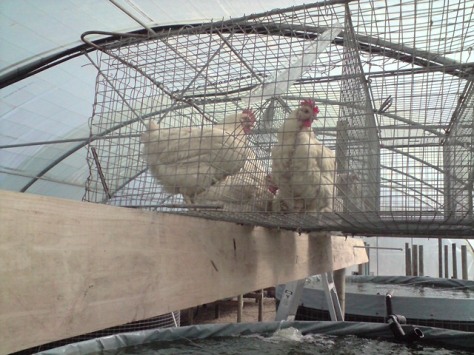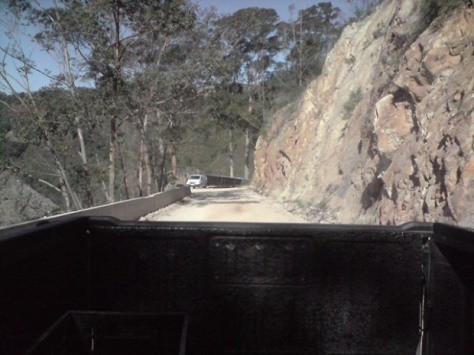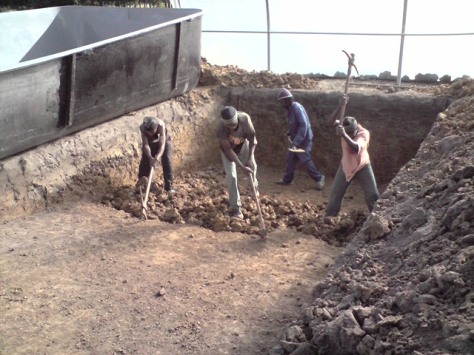A typical day in the life of Synaptoman. Thursday saw us finally introduce chickens to our commercial Aquaponic site. Chickens are the missing link, that will provide the much-needed nutrients, reduce the feed bill for the Tilapia and yield eggs for consumption or sale. We had a few choices. namely day-old chicks or fully grown fowls and broilers or laying hens. We eventually settled for laying hens, but the obvious question arose. How many chickens?
Before I answer this question, let me backtrack a bit and explain how chickens are going to fit into an Aquaponic setup. For the squeamish just skip the next paragraph.
Tilapia eat anything (very much like prawns and crayfish) but being mostly vegetarian any substitute feed would have to be from a vegetable source. Enter chicken dung. Tilapia thrive on this readily available source of food and are grown worldwide below chickens, ducks and numerous other poultry. The chicken dung in the water is also an excellent source of additional nutrients for the plants. Our plan is thus to place chicken coops over one of our Tilapia ponds.
Well, back to how many chickens. From a brilliant publication entitled, “THE VERTICAL FARM, Food Production of the Future” by the Columbia University Department of Environmental Health Sciences, (see their website here) I discovered that a laying hen poops 40 lbs per annum. This is 18kg per year or about 50g per day. In the pond we have 1500 fingerlings of say 25g each. 25g x 1500 fish = 38kg of fish. If I want the “poop” component of their diet to be 1% of their body mass per day I then need 380g of poop. Divide this by each hens contribution of 50g and we could use 380 / 50 = 8 hens.
I “chickened” out of this number and used 6 laying hens to try out the system. What concerns me is not so much the chicken dung which I know will be eaten, but all the other debris, feathers, feed etc clogging up my system and fouling the water. I am also concerned about dissolved oxygen (DO) levels. This is what the chickens look like suspended above the Tilapia pond.
We have 40 free-range laying hens available so they’ll each have to do a few hours of toilet duty a week to keep things flowing.
I performed water quality tests this last week and the system is looking good, with the bacteria in the gravel growbeds maturing nicely and starting to do their job, ie converting Ammonia to Nitrites and then to Nitrates which can then be taken up by the plants. Here are the results of the water test.

The readings are;
Ammonia 0.1
Nitrites 0.3
Nitrates 50
pH 7.5 – 8.0
At the other commercial site I have decided to use a reject swimming pool of about 25000L as a sump and we spent the week digging a suitable hole. I met the pool guy at Simola and guided him down the torturous pass and up the other side with the pool on the back of a trailer. I had to drive ahead with my hazard lights on and warn oncoming motorists of a wide load. This road, in places, is hardly wide enough for two cars so a 3.6m wide swimming pool might just present a problem.
Here is a shot of the pool coming around a hairpin bend with a sheer drop off on the one side.
We eventually got the pool to the site and continued digging the hole. It’s hard work and we are now into a solid clay layer.
On Monday the pool will go in and we’ll start planting the poles for the growbeds.
Enough for now
Synaptoman
And a VERY Happy Birthday to my daughter, Janys in the UK.




I have 30 chickens we free range them and I was wondering if it would help to just have the chickens over the fish at night, chickens do not see well in the dark and remain very calm. The other thing would be if you had them over a hard floor at night and just went in and scraped up the poop in the morning.
Richard
Very interesting story, good luck in your endeavors.
Well these chickens seem to enjoy their “duty” and seeing that they’ll only be suspended over the ponds in shifts I’m sure it’ll be a welcome change from what chickens normally do. Also, I don’t think an automatic fish feeder has been invented yet that is as effective as 6 chickens. Tilapia like many small feeds per day and with the chickens it’s as regular as clockwork.
Goodness, but you’re a busy little bee!
Believe me…. if you want chickenshit then you can get tonnes of it for free from chicken farms – in fact they pay you to take it away….. Also, Its great for grass if you let it shed some of its acidity ….
Now where are the plans for the small Bio Diesel plants…?
Tell me more about the acidity. Aquaponic systems have a problem with low pH and we buffer the pH with oyster shells so I wouldn’t want to add anything that causes any more pH drops.
As far as chicken shit being free, this won’t be for long as it’s a valuable source of methane gas and the farmers are realising it’s value to heat, run generators etc. The small bio-diesel plant plan will feature soon in a blog post. I’m playing with algae oil to bio-diesel at the moment.
so how did it go with the chicken sh*t?
is there an off tast?
No off-taste, no smell whatsoever. Dissolved Oxygen (DO) in the water has to be monitored carefully and chickens removed one at a time if levels get too low. The chickens mess their feed into the water when eating so one has to come up with innovative ways of feeding them as the excess food in the water causes Ammonia spikes and lower DO levels. The fish are growing at levels way in excess of normal feeding. The experiment has been a success and will be built upon.
why feed the chickens while they are over the tank. Feed them before and after they are removed from over the fish tanks, thus taking care of the excess feed falling into the fish water to foul the water.
What do you feed the chickens?
Thank you for the great poop calculations, it is a practical way to approach the question.
I hadn’t thought of the chickens,
I was going to try a worm farm for fish food supply.
Mushrooms and worms like chicken poop. (In controlled amounts.) It might be a low maintenance addition.
With a 25000L fish tank, what kind of yield do you expect?
Cheers
Chad.
We feed the chickens ordinary formulated corn-based feed for layers. Once we start harvesting algae from our algae pond for pressing oil for bio-diesel, we are going to try the algae husks as well. Any deficiencies detected in your plants have got to be introduced to the system via supplementary fish food in the form of Tilapia pellets.
With a 25000L tank you could harvest say 1500kg of Tilapia every 5-7 months depending on temperature and feed.
So it has been awhile since you have posted anything , how gows it with the tilapia and chickens?
I am keeping blue and nile tilapia in ansmall aquaponics setup ,
I also have chickens , havent got the ambition to put the two tegether yet , but it may be a fun wxperiment
The digestive tract of a chicken is very short, only 6 time its body length. Therefore, some of the foodstuff is excreted by the chicken before being fully digested. About 80 percent (by dry weight) of feed stuff is utilized and digested by the poultry, leaving 20 percent for use by the fish. Chickens while pecking; scatter about 10% of their food over the ground. This wasted feed is utilized directly by fish. The total protein content of dry chicken excrement can be as high as 30 percent. Usually, good chicken feed has a protein content of over 18 percent.NOTE the fish are utilising poultry feed and not excreta
Thanks Rob, your informative comments are highly appreciated.
Cheers
Synaptoman
Rob, Snyaptoman,
The chicken excreta falls directly into the fish pond/ tanks or is it captured dried and then fed to the fish?
Is there a formula for fish to chicken ratio?
It falls directly into the fish tanks. I no longer condone this method due to health concerns but the ratio was about 12 chickens to 50kg of fish mass, which provided enough nutrients for average growth.
what were the health concerns,
my chickens have been feeding my breeders since my last post 07/09
Sir years back like 1970 just south of Paris, Il. I done a number of jobs for a guy that raised 50,000 laying hens suppended in cages some five to six feet above the floor of his building which was 700 feet long. A bobcat was used to clean the chicken droppings out after building up to three to four feet under cages. Not sure what was done with the cleanings and wondered if this could be a source for your chicken droppings.
Sir another aspect to consider about chicken is the heat that they create. The person that had the 50,000 laying hens suppended above the building floor was always concered about heat built up in the building. Large fans were used to reduce the heat build-up in the building. The heat from a chicken operation could be used to heat a greenhouse or other buildings.
Hi Donmore,
Thank you for your comments. I am especially interested in the heating potential of chickens (and other livestock) for aquaponic systems. As mentioned in previous posts, I have some reservation re: the health issues (specifically Salmonella) of using chcken manure directly into fish ponds, especially layers where the potential for broken eggs to fall into warm water is high. Most interesting observation. Thank you.
Synaptoman
A chicken infected with salmonella can spread the bacteria from saliva, fecal matter, and eggs (from shell surface and within eggs). Eggs and raw chicken meat contaminated during slaughter are the most common modes of transmission to consumers. A sick bird in your system could easily contaminate your system with droppings not just a broken egg. Salmonella are not killed by freezing and must be heated quite high (hence 167F for cooking poultry) to be destroyed. They can survive outside a living body in both dry (weeks) and wet (months) conditions. Salmonella can also survive in fish. If your system also includes growing vegetables, they too can be contaminated with salmonella and are more likely to be eaten raw.
A common mode of chicken infection is through rodent droppings in chicken feed.
I would avoid direct addition of fresh chicken waste to any food production system as the risk for contamination is quite high.
Hi,
Thank you for your insightful comment. I agree with you 100% and that is why I no longer condone mixed fish/chicken culture in AP systems. Although it has been practised in the East for thousands of years it just isn’t worth the potemtial risks involved. The client in question still has chickens in his system but now the dried chicken manure is used to grow algae which is in turn fed to the fish, somewhat reducing the risk.
Cheers
Synaptoman
To solve the problem of direct entry of materials into a fish tank the chicken droppings could be collected and then selectively entered into the fish tanks.
I am not sure what causes the high heat build-up whether it is the presence of the chickens or their droppings or perhaps both.
I do remember that the 700 foot long chicken house had large 8 foot ceiling/roof fans that cooled the building and it was necessary to install a standby generator to pick up the load as I was told that in zero weather the chickens would start dying in one hour due to overheating if the electrical power was lost.
I am also interested in aquaponics on a commercial scale but did not think about the use of chickens until I read your commits, thanks.
The body heat of a chicken is said to be 102-103 degrees F. Seemingly a large number of chickens could be used to create the heating needs of a greenhouse or other buildings.
This also could work against a person in warmer climates.
I have don a lot of studding on this and found that to be successful (not spreading sickness) there needs to be at least two separations between the chickens and the fish. In Africa and Asia it has had spread nastiness starting with hook worm and much much worse bacteria and viruses. There are proven methods non potentially lethal ways of dealing with the chicken waist in aquaponics first and the safest is black soldier fly digester. Second is the teaing method and using the sun to pasteurized the tea. In this country where we have healthier livestock it is much less of a risk but still to risky for me. Here is someone that solved all of the problems http://www.aquaponicsearth.com/Aquaponics_Earth_Home.html
Black soldier fly digester is the best way of preventing sickness using the tea pasteurized from the digester straight into the grow beds or dirt garden and the larva to feed the fish. Set up a second digester to deal with other waist including the dead fish and guts to feed the chickens. This gives me a very clean operation with five separations of transmuting any sickness. The other thing is duck weed feeding the fish, chickens, rabbits and goats plus others. In areas that water is an issue the evaporation is dramatically cut down. Any overflow of duck-weed goes in to the digester giving me good soil. I also further compost from the digester into worm beds giving me more food and better soil. Do not ever feed the larva from the waist from what ever animal back to that animal just to be safe.
Hi Tim,
Thank you for your very interesting notes.
Synaptoman
just want to know can you feed rabbits pellets to tilapia fish
You can feed anything to Tilapia. Whether they will eat it is the question. Both rabbits and tilapia are herbivores so I’d say it wouldn’t do any harm. Feed VERY lightly and test if the fish take the pellet. If they do, slowly increase the feed and monitor water quality and fish growth. Oh, and please report back to us on your findings.
cheers
Synaptoman
Could you detail your five levels of separation? I am planning a system now…barrel-ponics first and then a 24 x 96 greenhouse. Duckweed and chicken poop are cheaper than store bought Fish Chow. Also, would pig poop work (Pig farm next door)?
As mentioned in previous replies, I no longer condone direct chicken/tilapia culture. I would feel more comfortable using the poop as food for algaes and duckweed in a totally seperate environment. I would not recommend pig poop although there is massive potential for methane production from this source for heating your system.
Synaptoman
what is the stocking rate and feeding rate of tilapia in tank system
It varies considerably depending on dissolved oxygen, the capacity of your filtration, both mechanical and bio. In pure aquaponics, I suppose 5-10kg / cubic m of water and up to 30-40kg for intensive aquaculture systems. I hand feed to satiation ie. until they don’t eat anymore.
Regards
Synaptoman
Very interesting concepts, definitely worth asking around about. but I would need more science behind this before I would be willing to consume or allow my family to consume such products, Very interesting both as a nutrient and heat source,
I just stumbled across this “chicken/tilapia/aquaponic” idea while watching an episode of “Doomsday Preppers”. Anything that promotes independence gets my attention so this is definitely something I might like to try (I am somewhat handy at building things but have not constructed anything like this). I have a few questions:
– about how much time per day/week do you spend maintaining the system?
– based on your current setup, how many adults would you say you could sustain? If children are involved, how many, how old?
– I’m sure any system like this is infinitely customizable, but could you provide a general idea of the flow and a basic list of components for your setup? For example: (chickens) – cages, feeding system/trays (gravel tray) – tray, gravel, bacteria (plants) – growing trays, etc.
I know I’m asking a lot, but I would appreciate any insight you could provide.
I take pleasure in, result in I found exactly what
I used to be having a look for. You’ve ended my 4 day long hunt! God Bless you man. Have a great day. Bye
Its a pleasure
This is a good blog I can’t believe I didn’t stumble upon it before!
Thank you. Your support is appreciated.
Well be experimenting with Quail farming as a part of our Aquaponic endeavors. We’re working with limited space, so Microfarming has become our strongpoint.
Keep an eye on us.
http://herbalalchemists.blogspot.com/p/about.html